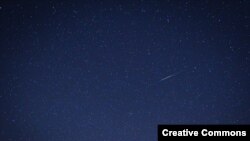One of the biggest meteor showers you’ve probably never heard of will peak tonight, likely around 20:00 UTC.
The Quadrantid shower always occurs at the start of the New Year, and while the intensity is on a par with the likes of the Geminid and Perseid showers--some 50 to 100 meteors per hour-- it only lasts a brief time--just a few hours. That means only the part of the Earth that is dark can enjoy the show.
For this particular edition of the Quadrantid shower, skywatchers in North Asia should have the best chance of seeing meteors as the peak will be shortly before dawn there.
If you’re going to try to see some shooting stars, the best place to look is high in the northern sky, near the Big Dipper. Because the focus is so far north, people in the Southern Hemisphere are unlikely to see much of anything.
The shower is named after a constellation that no longer exists.
The constellation Quadrans Muralis (Mural Quadrant), was named in 1795, and early descriptions of the annual shower said it radiated from it.
In 1922, during the inaugural general assembly of the International Astronomical Union, the list of the 88 recognized constellations was adopted and Quadrans Muralis was not included. The name of the shower retains the name.
The Quadrantid shower always occurs at the start of the New Year, and while the intensity is on a par with the likes of the Geminid and Perseid showers--some 50 to 100 meteors per hour-- it only lasts a brief time--just a few hours. That means only the part of the Earth that is dark can enjoy the show.
For this particular edition of the Quadrantid shower, skywatchers in North Asia should have the best chance of seeing meteors as the peak will be shortly before dawn there.
If you’re going to try to see some shooting stars, the best place to look is high in the northern sky, near the Big Dipper. Because the focus is so far north, people in the Southern Hemisphere are unlikely to see much of anything.
The shower is named after a constellation that no longer exists.
The constellation Quadrans Muralis (Mural Quadrant), was named in 1795, and early descriptions of the annual shower said it radiated from it.
In 1922, during the inaugural general assembly of the International Astronomical Union, the list of the 88 recognized constellations was adopted and Quadrans Muralis was not included. The name of the shower retains the name.









